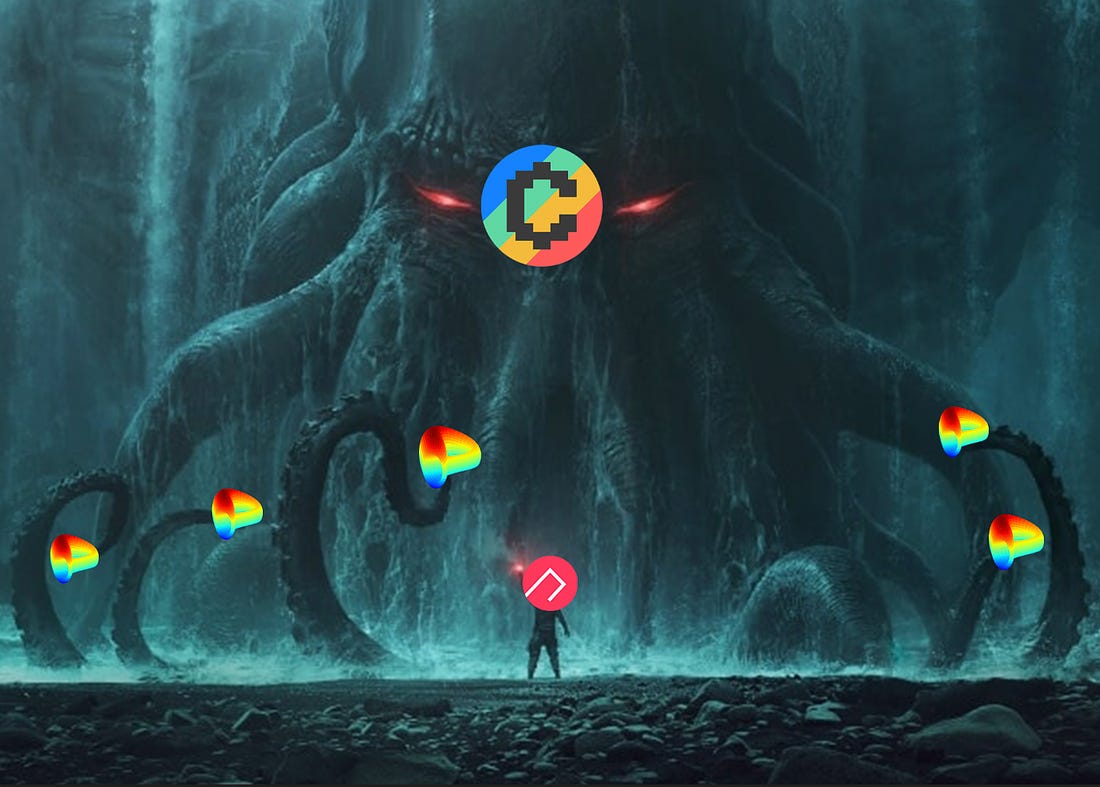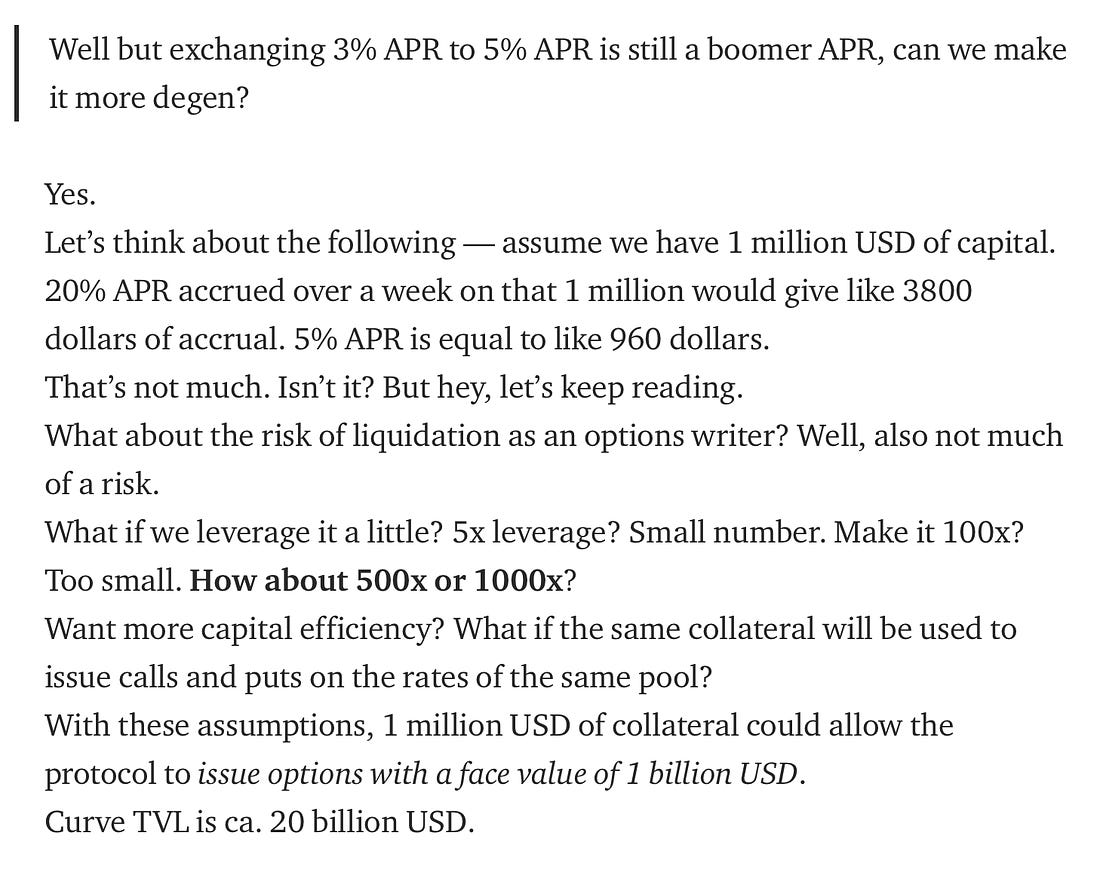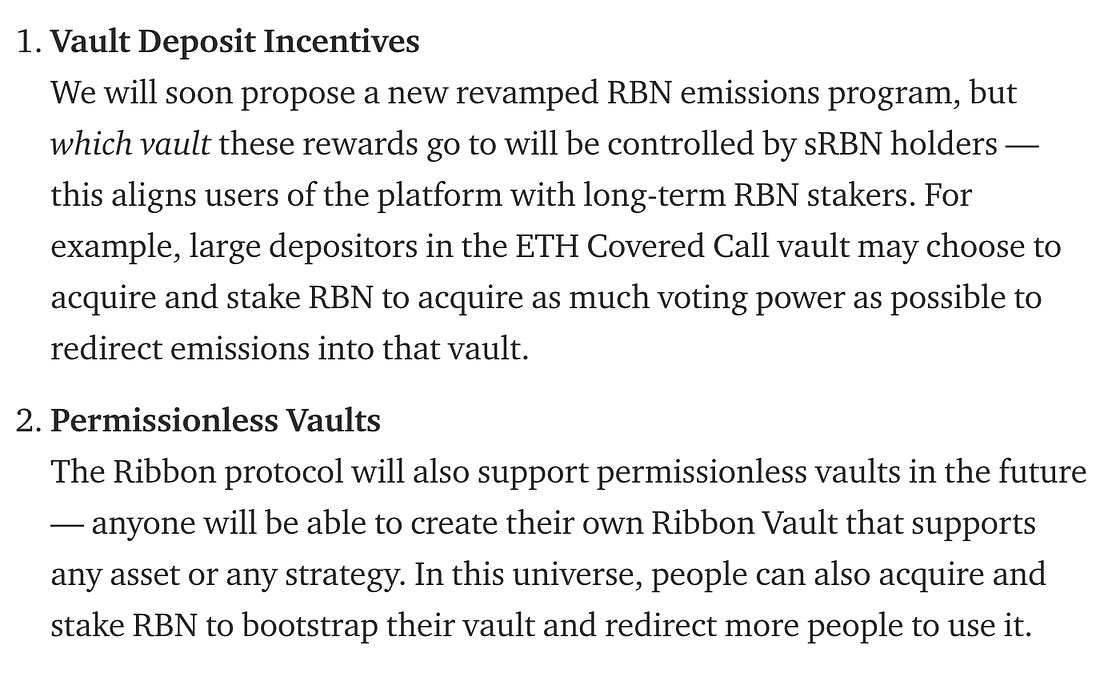In-depth Study of Dopex and Ribbon: DeFi Options Products are Rising

Author: knower
Original Title: 《A deep dive into Dopex and Ribbon》
Translation: Gu Yu, Chain Catcher
In late May 2021, a chain detective named @gabagooldoteth emerged in the crypto Twitter sphere. While doing some typical detective work, Gabagool (as we will refer to him in this article) discovered some suspicious activities related to Ribbon Finance.
Gabagool found that addresses associated with the now-defunct Divergence Ventures had been depositing 0.1 ETH into many wallets on Ribbon. This all happened before the Ribbon team announced an airdrop, sparking outrage in the community. After all, Ribbon is a portfolio company of Divergence, and effectively robbing your own investment firm is not a good look.
Through this simple and relatively cheap witch attack, Divergence Ventures profited around 719 ETH—worth over $2 million at today’s prices. As Gabagool's findings quickly spread across Twitter, Divergence continued damage control, essentially being forced to return the funds to Ribbon's treasury. A win-win for everyone? Well, it’s a bit more complicated than that. Of course, Ribbon received the stolen funds, but the damage was already done.
Naturally, everyone quickly forgot about this series of events within a day.
You see, after this airdrop debacle, many people forgot about Ribbon. While projects like dYdX, ENS, and Uniswap remained in the public eye in the weeks following their airdrops, Ribbon was completely overlooked. The token (RBN) has been trading in a brutal range since its launch, with many completely giving up on the protocol and few KOLs mentioning it.
Until now.
While many believe Ribbon's failure was due to a botched airdrop (which wasn’t their fault), the Ribbon team has been quietly working. The team has been researching a protocol whose ideas are quite unique and novel for cryptocurrency, but revolutionary for traditional finance—we will discuss this later.
As the Curve Wars heat up, Ribbon has quietly entered the fray. While still a small-cap (around $170 million at the time of writing), RBN has been making waves, reaching an all-time high of $3.81.
What triggered the recent breakout from the unappealing range, and how did Ribbon enter this crowded battle? Is Ribbon poised to rebound from a PR disaster and succeed in a turbulent market?
Spoiler alert: Yes, and it’s already happening.

But wait, there’s more
You’ve read the title and might think I forgot about Dopex. I chose to describe both protocols in the same article because I initially thought they were competitors. It turns out they are not, but they both deal with options, so the idea of the article still holds.
Dopex—short for "Decentralized Options Exchange"—is a protocol founded by the prolific @tztokchad. Before diving into Dopex and how it works, I will briefly introduce options, as they are relatively new to the crypto space, and many of my readers may need a refresher.
Essentially, options are agreements between buyers and sellers with some important limitations. Options give the right to buy or sell an asset at a specified price within a specified time. These are very beneficial for portfolios since none of us are wizards, and no one has a Chainlink oracle in their head to tell us where prices are headed.
Suppose I want to sell my Ethereum for $10,000, but it has been stuck at $4,000. Maybe I am 100% sure Eth will reach the elusive five-figure mark—I just don’t know when. With options, I can sell a secured call option, earning a premium in exchange for any upside above the $10,000 mark. I can choose to have the right to exercise it by December 2022, perhaps knowing Eth will rise a bit but not fully reach the exercise price.
If Ethereum hits a high of $8,000 before December, that’s great—I double my money, receive some premium, and keep my tokens. If the opposite happens and Eth hits $20,000, I might be a bit frustrated. Sure, I can sell at $10,000 and earn some premium, but I limited my upside and missed out on a 5x gain.
There are also put options, which are the opposite of call options—buying a put option means you expect the asset to decrease in value. You can also sell put options, which is similar to selling call options, as you bet that Theta (a complex options term) will decrease the value of the option rather than hoping the underlying asset will drop significantly.
That’s all I want to discuss, as it seems like a complex topic at first glance.
You may have heard of these options after Gamestop and Wall Street Bets made headlines a few months ago. While these financial derivatives attracted the attention of young retail investors, cryptocurrency and options have been an overlooked combination.
Dopex aims to provide a protocol that brings composability, fair and accurate pricing, minimal losses, and a world of decadence for those who prefer to live on the edge. But what are Dopex and Ribbon, and why did I choose to write about them instead of the money-printing chaos happening on Convex land?
Well, the answer is a bit complex. I need you to dream with me here.
The Wild World of DeFi Options
I will start with Ribbon, as I discovered them before Dopex—or maybe because they have a cooler user interface; I’m not sure. Either way, let’s dive into the details and see what the fuss is about.
While Dopex caters to a broader degen community, Ribbon aims to provide a product for those looking to earn stable returns by selling Theta. If you’re looking for more information on this, I recommend checking out @ThetaTendies on Twitter—that’s his name.
Ribbon’s core product is its Theta Vaults—currently offering secured call vaults on WBTC, AVAX, STETH, and more. Ribbon can promise high yields without worrying about liquidity mining. While many protocols typically pay 6-8 figure LP tokens to hired farmers, Ribbon can promote healthy and attractive yields through the power of selling options—pretty neat.
Built on top of Opyn (I believe), Ribbon is able to utilize ERC-20 tokens that operate as options. I’m not too versed in the details, but Ribbon can leverage the backbone created by Opyn to deliver their theta vaults—something unique to this space.
Ribbon’s theta vaults are unique because they are fully automated. In traditional markets, you might need to find the strike price and expiration date yourself or have a portfolio manager do it for you. Ribbon offers passive investors a "set it and forget it" option vault. Well, as passive as investing in cryptocurrency can be.
I would say that for 99.9% of traders, crypto + options sounds like a deadly combination, but I would support it because I look forward to seeing more posts about it.
Ribbon’s theta vaults are an example of structured products, a quirky term for a set of financial instruments that utilize derivatives to achieve specific goals—this definition can be attributed to @chudnovglavniy, a brilliant developer at Ribbon.
I am very optimistic about structured products in DeFi, but I will elaborate on that later. Due to Ribbon’s pioneering position in the DeFi structured products space, they have been able to attract over $300 million in TVL. If you ask me, the protocol can play a significant role and generate revenue.
This might be a good introductory read on the work Ribbon is currently doing. If you’re interested in learning more (and you should if you plan to invest), check out their documentation—it has helped me a lot.
Moving on.
Dopex is similar to Ribbon but operates slightly differently, offering two products: options pools and single-staking options vaults (SSOV). Let’s start with the options pools.
If users want to purchase standard call options or buy an asset, they can do so through Dopex. Whether it’s ETH or some other asset, you can put your money where your mouth is and try your luck with some European options. Unlike WSB, you cannot sell these products before the expiration date, but you can still earn more money with them compared to not buying. Over time, I believe crypto options will become larger and more complex, so practice a bit on Dopex now before it’s too late.
If you’ve never looked at options before, check out InTheMoney on YouTube—that’s how I got started, and now I can lose money on options without looking up any tutorials.
Dopex’s other product—SSOVs—is similar to Ribbon’s theta vaults, as users can deposit their assets and sell secured call options, earning yields through things like gOHM and rDPX (Dopex’s rebasing token). One key difference, which has been pointed out to me, is that while Ribbon’s vaults are fully automated, Dopex is not yet.
Also, I apologize for all the hyperlinks. There’s too much extra information that doesn’t fit into this article, so click around for some extra tidbits; it should help.
Dopex has stated that they plan to bring over $500 million in TVL from SSOVs. When new protocols want to gain more users and TVL, they are forced to spend large amounts on LP tokens and deal with hired farmers. Who says Dopex can’t organically raise this money by offering stable returns and minimal losses? To me, it feels like a no-brainer.
Dopex aims to replicate the success of Robinhood and Deribit—all decentralized, and if you’ve watched CNBC in the past year, you might know about Robinhood’s lack of transparency and overly centralized structure.
The Money Printer and Looking Ahead
"But what does this have to do with Curve—"
Oh, how could I forget?
After stumbling upon the Ribbonomics article published by Ribbon on Medium, I was inspired to write this piece. So, what exactly is Ribbonomics, and will we be teaching high school students about it in the near future?
You may be well aware that Curve Finance has achieved the greatest DeFi tokenomics through its veCRV and gauge voting mechanism—perhaps the greatest we’ve seen. Due to these seemingly simple and harmless incentives, Convex Finance and other protocols initiated the Curve Wars.
With the immense success of Curve and Convex—each boasting $24 billion and $20 billion in TVL, respectively—Ribbon has begun to mimic some of that tokenomics. Let me introduce you to the concept of useful governance, or useful governance tokens. Allow me to explain.
Many protocols have a governance token, which is great and fun for team members and early investors, but often a bad time for investors due to inflated FDV and a lack of foresight from the protocol. The DeFi protocols are countless.
Maybe you can vote on concise proposals with these tokens or use them to provide liquidity. I don’t know, maybe there’s more to do. Perhaps you just like holding it because it feels cool.
Ribbon wants to address this issue. Sure, many protocols have 9 or 10-digit TVLs and are greatly undervalued, but how many protocols have good tokenomics? Sure, RBN’s FDV is very high. But they are addressing this by adding the greatest tokenomics in DeFi history, the veCRV model.
If it’s not obvious enough, let me show you veRBN.
"But how do you replicate the veCRV token—"
Silence, innocent one. I minor in Ponzi economics; I know my stuff.
I get it, you might be wondering how bullish this is and how governance tokens can meaningfully transform their tokenomics. Let me give you some alpha.
In recent months, CRV and CVX have injected unhealthy amounts, and that will only continue. Even YFI surged after their tokenomics reform announcement. What do you think RBN will do? Do you really think options won’t become the next big thing in DeFi?
Position yourself accordingly.
With the implementation of these new tokenomics, the longer users lock RBN, the more rewards they can earn and the more governance weight they gain. If that’s not enticing enough, remember the "guaranteed" yield from selling theta that I mentioned. Because Ribbon doesn’t have to rely on hired farmers, they can always maintain a healthy TVL, meaning they always earn revenue, and stakeholders can always earn a portion of the fees. Here’s a small excerpt from the Ribbonomics article:
It’s that simple. Ribbon is made for these tokenomics, and it’s a shame it didn’t come sooner.
I almost forgot about DPX—how could I do that? While I am very excited about Ribbon’s arrival, if I said I wasn’t more excited about DPX, I would be lying.
It’s voting delegation season, so I might as well introduce you to veDPX. No, I’m not joking; this is happening too. Dopex plans to add [Redacted] options vaults, which essentially allow users to bet on which direction the Curve gauge swings. Yes, you can bet on the curve wars with options.
Things are only going to get weirder.
While I could try to give you another decadence-centered scenario, Halko put it best with this tidbit:

This is a massive influx of funds into Dopex, which means massive revenue, which means massive accrued value returned to veDPX holders. Oh, I forgot to mention the part about effective governance. I don’t know about you, but speculating on options to control the Curve wars sounds very useful and impactful to me.
Dopex has also stated they plan to add SSOVs for cvxFXS (this is huge), SPELL, AVAX, and more—this is incredibly bullish. Just the options for SPELL alone are enough to put the entire frog nation in a bind, and mixing in cvxFXS is almost dangerous.
As DeFi and the options of Ribbon/Dopex continue to expand, with user numbers and TVL on the rise, I will watch with hopeful anticipation. I can’t help but feel excited about the future, as the war seems to have just begun.
Final Thoughts
Despite RBN’s FDV being off-putting, I am bullish on RBN and DPX in the long term. If the price hits $10, maybe I will sell—maybe I won’t. Sometimes I really don’t know if I believe these options will create a huge stir in the crypto space and provide a new paradigm for speculators at all levels? The answer is yes.
Both protocols have healthy 9-digit TVLs; I believe Ribbon’s is currently around $250 million, while Dopex’s is likely slightly above $500 million. I expect these numbers to double in the coming months.
I won’t tell you what to buy or when to buy it. None of this is reasonable financial advice. My main goal is entertainment, and I hope I’ve achieved that.
What I do know is that both protocols are fundamentally sound, and it would be foolish not to support them and their noble goals. I hope you enjoyed this article, and remember to do your own research before buying any of the token codes I mentioned.
Thank you for reading, and a special thanks to my 1,000 subscribers.
A special thanks to @xenes1s, @0xCasio, @Halko500k, and anyone else I forgot to mention for providing all the information!












